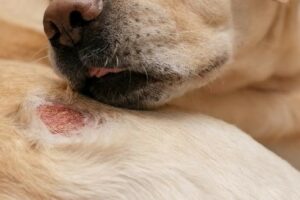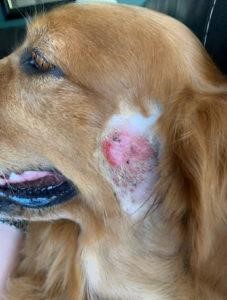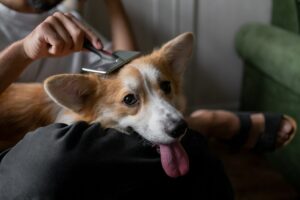What are hot spots?
Hot spots are skin lesions that are red, itchy, moist, and often oozy or crusty in appearance. These lesions are generally caused by self-inflicted trauma, when a dog constantly scratches, licks, or chews at a specific area until an open wound is created. This is referred to as the lick-itch-lick cycle, the basis of hot spots.
The initial itch or discomfort can be a result of the following:
- Allergies – food allergies, inhalant or contact allergies can cause itchiness (i.e. grass, pollen)
- Insect bites – commonly due to fleas as they can cause Flea Allergy Dermatitis, mites, or other small insects (i.e. gnats, mosquitoes, lice)
- Poor grooming – Matted fur prevents air from reaching the skin and retains moisture after getting wet. This sets up a perfect environment for bacteria, fungus, and yeast to grow. Dogs with unkempt coats may also persistently chew at tangles, causing lesions.
- Ear Infections – Bacteria or yeast in the ear can cause discomfort, often leading dogs to scratch at their ears. This constant scratching causes hot spots around the ear and neck.
- Orthopedic issues – Constant licking and chewing of pressure sores and aching joints can lead to hot spots.
- Anal gland inflammation – Infected or impacted anal glands are uncomfortable for dogs. Licking around this area can cause hot spots under or on top of the tail.
Hot spots tend to emerge on dogs suddenly, without any warning. They can begin as a small spot similar to a bug bite, which your dog will lick, chew and scratch. This behaviour speeds up the spread and causes it to get worse. If you don’t immediately control these lesions, they can spread very fast. In fact, a hot spot can grow from a tiny red dot to 5 inches in diameter within a couple of hours. Breeds with thick or long hair are most frequently impacted.
 What do hot spots look like?
What do hot spots look like?
- Inflamed and sore skin
- Moist and raw skin
- Hair loss in the affected area
- Oozing clear or yellow discharge that forms a crust
- Bleeding
You should seek veterinary attention if you notice these symptoms on your dog. Your veterinarian will attempt to determine the cause of the hot spots, treating both the underlying condition and prescribing the care needed to make your dog comfortable while the hot spots heal. Treatment usually involves medication (i.e. antibiotics, corticosteroids) and shaving the hair surrounding the lesions to allow for medication to be applied effectively and for airflow to help dry out the affected area. To prevent self-inflicted trauma, the use of an Elizabethan collar may be recommended.
Preventing hot spots
Preventing hot spots on your dog is an ongoing process that will also support ongoing good health. Here are our top tips:
- Parasite management – Follow a strict flea and tick prevention program as recommended by your veterinarian. (i.e. Bravecto, Nexgaurd, Simparica) to keep the parasites away
- Grooming – Regular grooming appointments are essential for curly coated, long coated, and double coated breeds. Not only do professional groomers make dogs look and feel wonderful, but we also offer essential services that contribute to your animal’s health. Groomers often notice small lumps, bumps, lesions, and any other abnormalities that may be hidden under your dog’s coat and can advise you of any areas to keep an eye on. At Paddington Pups, grooming appointments are not limited to a full body clip, we also offer maintenance grooms and combos (bath, blow dry, and brush out). These services are perfect for owners who would
 like to grow out or maintain a long, fluffy coat. Click here to read more about our grooming services, or to make an online booking!
like to grow out or maintain a long, fluffy coat. Click here to read more about our grooming services, or to make an online booking! - Brushing and coat maintenance – Prevention of matting is also key in avoiding hot spots. Matted hair traps in moisture and dirt, creating a perfect breeding ground for skin infections. Daily brushing and coat maintenance at home in between grooming appointments is crucial to prevent matting, as well as bathing and fully drying after any water-related activities. There are many videos online showing easy at-home techniques for brushing your dog. Click here to view one that our groomers recommend watching.